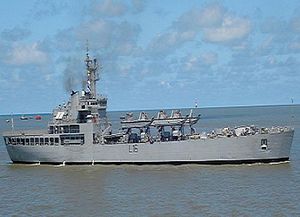The Indian Navy has sent one of its three Shardul-class amphibious warfare ships to a maritime security and counter-terrorism exercise led by the Association for Southeast Nations (ASEAN) in the South China Sea.
INS Airavat arrived in Brunei to participate in the ASEAN Defense Ministers Meeting (ADMM) Plus Exercise on Maritime Security and Counter-terrorism. The exercise will last until May 9.
“Indian Navy and the navies of ASEAN countries have a mutual interest in promoting peace and prosperity in the Indian Ocean and the Western Pacific, given our shared maritime security interests,” the Indian Navy said in a statement.
Indian Navy ships have made regular port calls with ASEAN member states in recent years. The Indian Navy, per its maritime security strategy, considers the South China Sea a zone of secondary interest.
The Indian Navy also said that its participation in the exercise is intended to “enhance maritime security in the Indo-Pacific.”
The INS Airavat is an indigenously designed amphibious warfare ship, capable of carrying 500 troops, 10 armored vehicles, and 11 combat trucks. The ship is armed with two WM-18 rocket launchers and 4 CRN-91 30mm guns.
The ship has recently seen use in domestic humanitarian assistance and disaster relief (HA/DR) scenarios, most recently after last December’s devastating floods in the southern Indian city of Chennai.
In addition to India and ASEAN states, the United States, Japan, Russia, Australia, and China are participating in this year’s exercise.
All participating states have stakes in security outcomes in the South China Sea, where regional tensions have been high amid flaring maritime and territorial disputes between China and four ASEAN claimants–the Philippines, Vietnam, Malaysia, and Brunei–in recent years.
Since 2014, when India’s new government led by Prime Minister Narendra Modi came to power, India has defined its outreach toward Southeast and East Asian states as increasingly dynamic, under the “Act East” policy.
Modi’s “Act East” slogan updates India’s early-1990s “Look East” policy, which saw India’s post-Cold War security outlook increasingly gravitate toward eastern Asia.

































